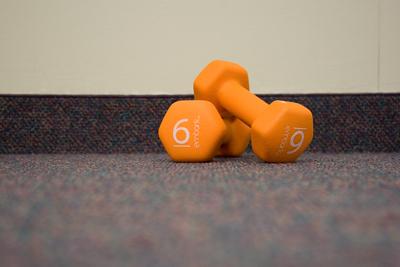
(Sidney Hollingsworth/The Daily Campus)
Many of us think that just because we go to the gym often, we know what we’re doing.
But common mistakes befall many people during their workouts.
Are you one of them?
Dedman’s very own personal trainer, Alex Vasile, shares the top five things she sees students doing wrong at the gym and how they can improve their routines.
1. Skipping the warm up and the cool down.
Many students skip the warm up and the cool down for the sake of time and convenience.
By doing this Vasile said “they are greatly increasing their risk of injury.”
If muscles are not warm and pliable, they are much more likely to painfully tear or pull upon exertion.
Want a quick fix?
Ease yourself in and out of your workout with easy cardio and stretching.
2. Exclusively cardio or strength training.
By neglecting either facet of exercise, students are not meeting the five fitness components – strength, flexibility, endurance, cardiovascular and body composition – that represent how fit the body is as a whole.
Cardio activities such as running, biking and swimming contribute to the cardiovascular component by improving heart health and cardiovascular endurance necessary for prolonged periods of exercise.
Strength training such as weight lifting or bodyweight exercises contributes to the strength and endurance components.
“Strength refers to hypertrophy (muscle growth) and endurance refers to being able to lift light weights many times,” Vasile said.
Strength training with a consistent, low weight with a high number of repetitions develops endurance while lifting increasingly heavier weights causes an increase in the size of myofibrils or muscle fibers and growth in the muscles. Enlarged muscles create definition.
Great workout routines include both cardio and weight training.
3. Holding onto cardio equipment too tightly and putting too much weight onto handles.
Although railings and handles are there for stability, students are using them as a way to compensate for going too fast or at too great of an incline.
Grabbing the handles takes some of the work away from the lower body.
“Let go! Slow down the pace or lower the incline if need be,” Vasile said.
By lightening up your grip on the handles, you direct the exertion to the lower body, experience the full burn in that area, and find an appropriate pace and incline.
4. Relying on old fashioned, often improper, weight lifting technique.
Vasile often notices the use of improper, dated weight lifting technique that could lead to injury.
“Go by current reliable sources such as nationally recognized organizations that work on providing proper exercise technique (ACSM, ACE, NASM, NSCA), instead of listening to Youtube, fitness magazines or peers that could offer dated advice,” she recommended.
“For example, workout technique displayed in Jane Fonda’s dated workout tapes might not be correct today. Research and ask questions to find current, proper weight lifting technique.”
5. Jerky movements while lifting weights.
“Many people wrongly use momentum as opposed to strength and actually lifting the weight because their weight selection is inappropriate for them,” Vasile said.
“Lower weight and proper form is preferable to heavier weight and incorrect form.”
Don’t be afraid to start small and work your way up.
Lifting weights that are too heavy for you force you to compensate with jerky movements that are ineffective and often leads to injury.
Be mindful of these common problems to maximize your workout and stay safe, effective and looking good at the gym.
*Personal trainer Alex Vasile is AFAA Primary Group Exercise and Personal Fitness Trainer certified. She has been personal training for two years and group training for almost three years.








